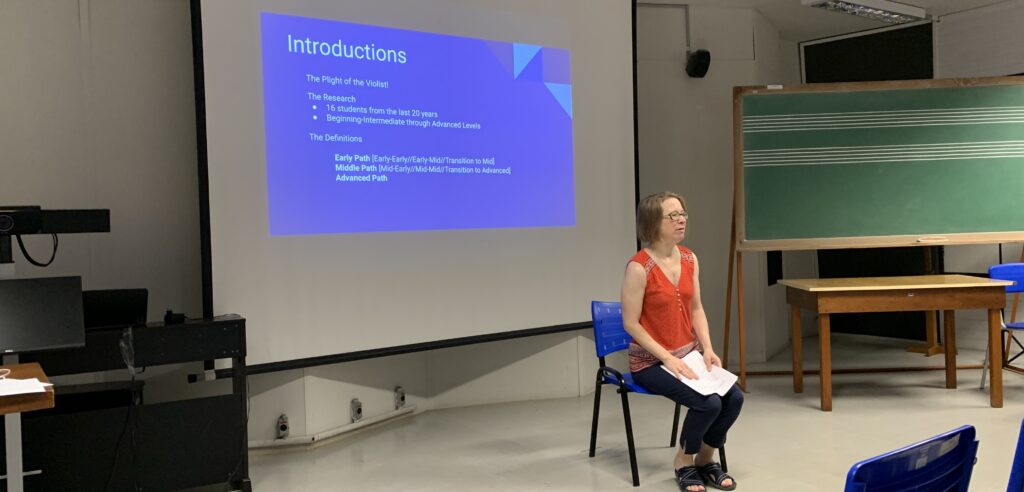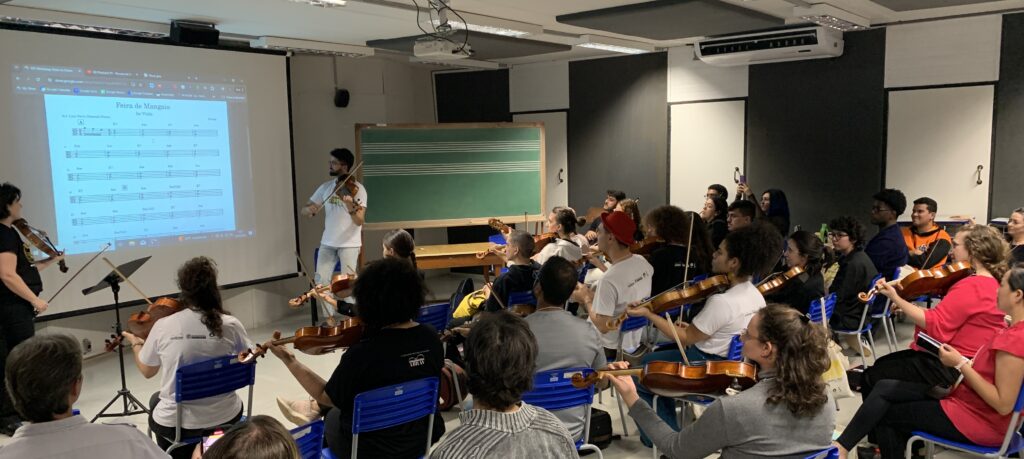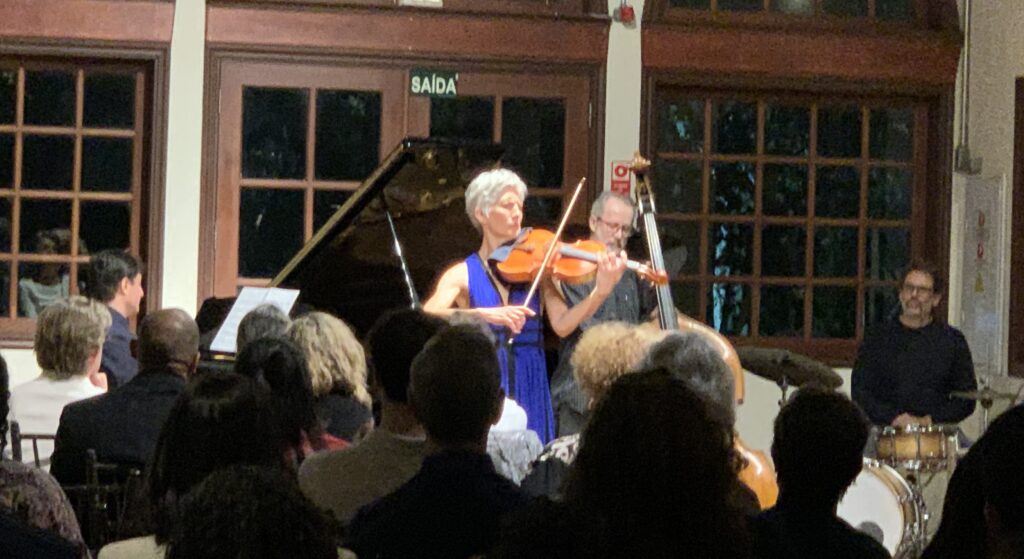The 49th International Viola Congress takes place from 17-21 July in Campinas, Brazil. Your intrepid DVS bloggers bring you the daily debrief from the pulsating heart of the viola world.
Day 3 – Friday, July 19th 2024.
A really early start today with a 08:30am Viola Orchestra rehearsal of the new piece “Festa Pra Donatella“, composed by Newton Carneiro for the Congress. Donatella is the name of the composer’s soon-to-be-born daughter. This piece is for 4-part viola ensemble with 2 solo parts, assigned to our very own Ursula and Sunniva! There are significant rhythmical challenges, esp. given the size of the ensemble. The composer therefore conducted this piece himself.
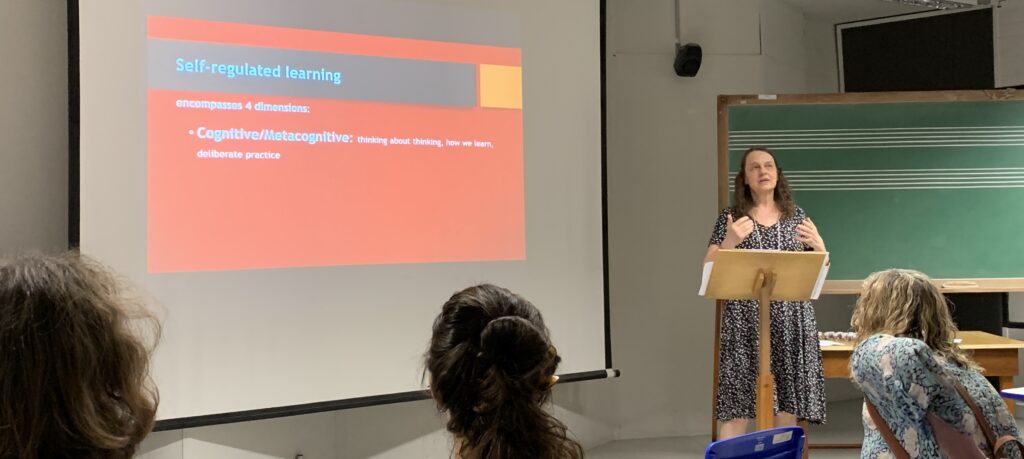 At 10am we followed the lecture “Student-centered teaching and the development of self-regulated learning” by Hella Frank. This “new” learning model is in clear contrast to the classical “Teacher-centered” learning model, where teacher hands out instructions to a passive student that is not expected to provide any inputs. In the Self-Regulated learning model, the student instead has to drive his/her own feedback loop to a point where it becomes continuous learning and improvement. The teacher helps the student to analyse deficiencies and to find solutions, but in a dialogue rather than as a one-way stream of directives. The teacher helps the student clarify his/her goals, and in doing so should strive for a non-controlling approach, always providing multiple options.
At 10am we followed the lecture “Student-centered teaching and the development of self-regulated learning” by Hella Frank. This “new” learning model is in clear contrast to the classical “Teacher-centered” learning model, where teacher hands out instructions to a passive student that is not expected to provide any inputs. In the Self-Regulated learning model, the student instead has to drive his/her own feedback loop to a point where it becomes continuous learning and improvement. The teacher helps the student to analyse deficiencies and to find solutions, but in a dialogue rather than as a one-way stream of directives. The teacher helps the student clarify his/her goals, and in doing so should strive for a non-controlling approach, always providing multiple options.
Next came a program we certainly had been looking forward to: “New Folk Romantic Music from Norway” with Povilas Syrrist-Gelgota. We first met Povilas at the congress in Thailand last year. He’s a great performer, using his whole body and supplements with an impressive voice that is integrated in his music. By “New Folk Romantic Music” the emphasis is on the first word – these are new compositions (many of them his own), but in a romantic style; for example Vidar Kristensen’s “The Norse Voyager“, which includes some historical perspectives from when the first viking explorers/conquerors sailed deep into the Meditteranean and up the Russian rivers. Entirely unforgettable was “Crazy Horse”, where Marcin Murawski joined him on stage in a kind of rodeo act.
After lunch we visited the lecture “Finding Smooth Pathways Through Viola Literature” by Andrea Houde from West Virginia University – basically concerned with designing a repertoire list (trajectory) for a Bachelor student. Key point was to find a path with a smooth learning curve, tailored to the talents and skill gaps of a student – seeking to avoid traumatizing roadblocks. It’s important to understand the student’s background, starting point and goals/motivations before drawing up this list of coursework.
By simply remaining seated, we went straight to the next session on the program, a talk titled “Some Ideas About Viola Making” with luthier Luis Claudio Manfio from São Paulo. Manfio specializes in building violas (only!), and after having briefly reviewed the classic Italian (Brescia and Cremonese) viola models, he explained the key factors of relevance for violists choosing a viola model: Shape, size, dark/bright sound, dynamic range, clarity/evenness of sound, responsiveness and so on. He then went on to demonstrate how he tackled different challenges and tradeoffs in his viola designs.
Next on my program was the performance “Contrasts and Connections” with the Piedmont duo (Ayn Balija on the viola and I-Jen Fang, percussion) from the University of Virginia. They played a selection of pieces by “underrepresented composers”, but it was not clear (to me) from the program notes in which sense these composers are considered “underrepresented”, as they mostly seem to have (had) quite successful careers in general. But their names (Marco Schirripa, Melanie Farrin, Ney Rosauro and others) are unknown to me, perhaps demonstrating at least that composing for viola and percussion is not your easiest path to gain widespread recognition. I really enjoyed the performance anyway.
Time for some action – in the workshop titled “Language of Choro on Viola” with Luiz Freire and Camila Meirelles. This particular type of Brazilian popular music has been around for almost 200 years, in fact preceding Jazz, but including similar aspects of rhythmic and harmonic improvisation. We learned by group exercise to emulate rhythms and articulations used as the fundament for further improvisation. Good fun, and also a cultural eye-opener for me. It’s stuff like this that justifies travelling 10,000km to go to a viola congress!! Musical styles you have no exposure to at home: if you don’t know it exists and don’t ask for it, you also won’t find it in today’s algorithm-based internet bubbles. It’s rather paradoxical that the Internet hasn’t contributed much to increasing cultural awareness.
In the evening we were transported by bus to the venue of the Gala concert – the Sala Watari. Finally a nice acoustic concert hall with no drone of airco! And a very nice atmosphere it has, too. Principal violist of the Pittsburgh Symphony Orchestra Tatjana Mead Chamis was this evening’s featured artist. The first half of the program she played together with renowned Brazilian composer/pianist André Mehmari – who composed most of the music on the menu. Most impressive was his Viola Sonata, with the vibrant “Maracatu” – a rhythmic dance from the Northeast of Brazil – forming an exciting backbone of both the first and last movements.
The last part of the concert consisted of “Bachiana Brasileira 2.0” for Solo Viola and Jazz Trio. The title refers to the original suite of pieces written by Heitor Villa-Lobos, combining Brazilian music with Bach. Some of the most famous ones feature the cello prominently, while the viola is at best a tutti supporter in the string orchestra. In this new 2.0 version created by Flavio Chamis, selected movements from Bach’s cello suites (played on the viola) are answered by a jazz trio arrangement with a particular Brazilian flavour, e.g. Prelude – Frevo, Allemande – Samba Canção, Courante – Gaudério Gaucho and ending with a Gigue – Bailão. Lots of fun surprises in the jazz bits!
The musical treat was followed by a gastronomical treat in the form of a Brazilian buffet dinner at Espaço Malbec, a quaint restaurant at the outskirts of Campinas. But before we could eat, there were some traditional ceremonies to be observed. Firstly, the annual “Silver Alto Clef” award. This year it has been awarded to Konrad Ewald, the man behind the invaluable book/catalogue “Musik für Viola” (aka. Music4Viola.info). The IVS Presidency (Jutta and Karin) had personally visited mr. Ewald in his retirement home in Switzerland, and we were now shown the video recording of the award ceremony held there. A resounding and heartfelt “THANK YOU, KONRAD EWALD” was recorded from the IVC crowd which will be transmitted to him.
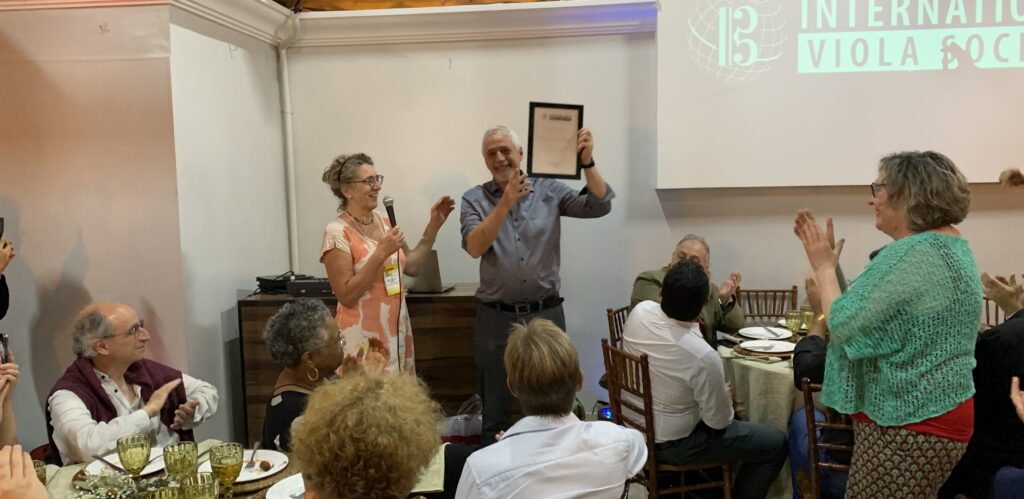 The next ceremonial task was to duly thank our host Emerson de Biaggi with a proper IVS Certificate of Appreciation, and Karin Dolman received a special token of appreciation from her IVS board colleagues. And last but not least the announcement of the next International Viola Congress, by way of a very impressive “welcome” video by the future hosts: It will be in (… drum roll …) Xi’an, China! from 13th-17th of August 2025. The call for proposals is hereby opened. So make your plans for “Viola army meets the Terracotta Army”!
The next ceremonial task was to duly thank our host Emerson de Biaggi with a proper IVS Certificate of Appreciation, and Karin Dolman received a special token of appreciation from her IVS board colleagues. And last but not least the announcement of the next International Viola Congress, by way of a very impressive “welcome” video by the future hosts: It will be in (… drum roll …) Xi’an, China! from 13th-17th of August 2025. The call for proposals is hereby opened. So make your plans for “Viola army meets the Terracotta Army”!
But first, we’ve got 2 more Congress days to go here in fantastic Campinas!
Kristofer Skaug, DVS



